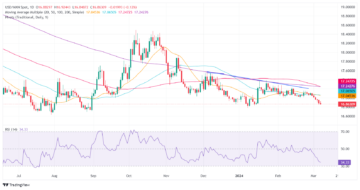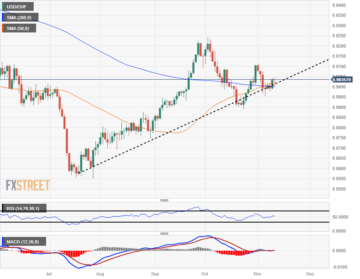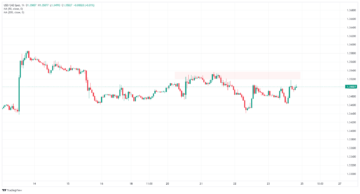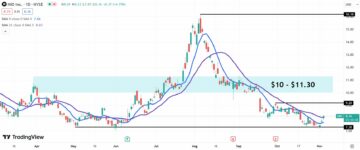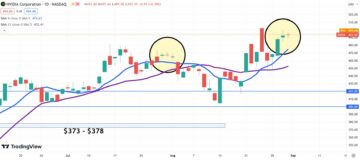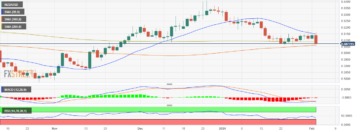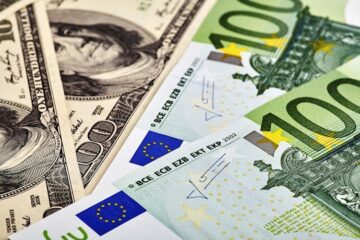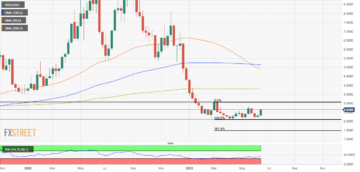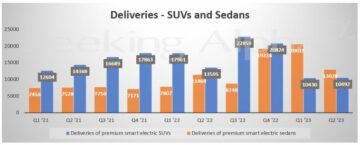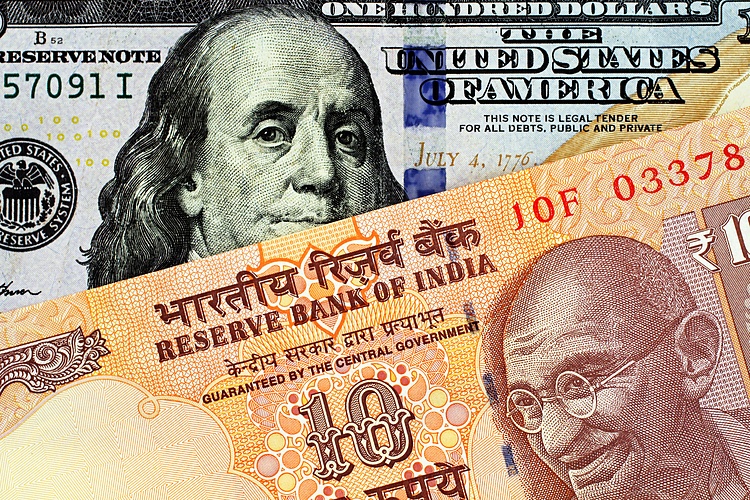
- Indian Rupee loses ground despite the modest decline of the US dollar Index.
- RBI’s Das said cutting the key policy rate would be premature until the 4% inflation target is achieved on a sustained basis.
- The US Purchasing Managers’ Index (PMI) report will be due on Wednesday.
Indian Rupee (INR) trades on a softer note on Tuesday. The Reserve Bank of India (RBI) Governor Shaktikanta Das stated last week that cutting the key policy rate would be premature until the 4% inflation target is achieved on a durable basis. RBI’s Das said Indian Consumer Price Index (CPI) inflation has decreased from a peak of 7.8% during the Ukraine-Russia conflict to within the RBI’s target range of 2–6%. However, new geopolitical flashpoints are emerging, and climate change and weather-related events are also affecting food prices.
Investors will focus on the US Purchasing Managers’ Index (PMI) report on Wednesday. The preliminary US S&P Global Services PMI for January is expected to ease from 51.4 to 51.0, while the Manufacturing PMI is estimated to remain steady at 47.9. The attention will shift to the Q4 US Gross Domestic Product Annualized on Thursday and the December Core Personal Consumption Expenditures Price Index (Core PCE) on Friday. Indian markets will be closed on Friday for Republic Day.
Daily Digest Market Movers: Indian Rupee remains sensitive to inflation and global factors
- According to the Reserve Bank of India (RBI), India’s foreign currency reserves climbed by USD 1.634 billion to USD 618.937 billion in the week ending January 12.
- India’s Foreign Direct Investment (FDI) has surged in the last few years, increasing from $36 billion in 2014 to $70.9 billion in 2023.
- The markets have priced in 42% odds for a rate cut at the March meeting, a slide from 70% just a week ago, according to the CME FedWatch Tool.
- San Francisco Fed President Mary Daly said the central bank has a lot of work left to do on bringing inflation back down to the 2% target, and it’s premature to think interest-rate cuts are around the corner.
- The monthly and annual Core Personal Consumption Expenditures Price Index (Core PCE), the Fed’s favorite inflation gauge, are projected to show an increase of 0.2% MoM and 3% YoY, respectively.
Technical Analysis: Indian Rupee remains range-bound between 82.80 and 83.40
Indian Rupee trades weaker on the day. The USD/INR pair remains stuck within a multi-month trading range of 82.80–83.40. USD/INR holds above the key 100-period Exponential Moving Average (EMA) on the daily chart. However, the bullish outlook of USD/INR looks vulnerable as the 14-day Relative Strength Index (RSI) stands below the 50.0 midline, indicating that additional decline cannot be ruled out.
The upper boundary of the trading range at 83.40 acts as a critical resistance level for USD/INR. The additional upside filter to watch is a 2023 high of 83.47, and finally the 84.00 round figure. On the other hand, an initial support level is seen at the 83.00 psychological mark. Any follow-through selling below 83.00 will expose 82.80 (the lower limit of the trading range and a low of January 15) and 82.60 (low of August 11).
US Dollar price in the last 7 days
The table below shows the percentage change of US Dollar (USD) against listed major currencies in the last 7 days. US Dollar was the strongest against the Japanese Yen.
| USD | EUR | GBP | CAD | AUD | JPY | NZD | CHF | |
| USD | 0.44% | -0.10% | 0.21% | 0.75% | 1.54% | 1.47% | 1.25% | |
| EUR | -0.44% | -0.53% | -0.21% | 0.32% | 1.09% | 1.03% | 0.82% | |
| GBP | 0.09% | 0.52% | 0.30% | 0.85% | 1.62% | 1.55% | 1.34% | |
| CAD | -0.22% | 0.21% | -0.32% | 0.53% | 1.31% | 1.25% | 1.03% | |
| AUD | -0.77% | -0.32% | -0.85% | -0.54% | 0.78% | 0.72% | 0.50% | |
| JPY | -1.55% | -1.11% | -1.65% | -1.41% | -0.79% | -0.06% | -0.28% | |
| NZD | -1.49% | -1.04% | -1.57% | -1.27% | -0.72% | 0.08% | -0.22% | |
| CHF | -1.27% | -0.82% | -1.36% | -1.05% | -0.50% | 0.27% | 0.21% |
The heat map shows percentage changes of major currencies against each other. The base currency is picked from the left column, while the quote currency is picked from the top row. For example, if you pick the Euro from the left column and move along the horizontal line to the Japanese Yen, the percentage change displayed in the box will represent EUR (base)/JPY (quote).
Interest rates FAQs
Interest rates are charged by financial institutions on loans to borrowers and are paid as interest to savers and depositors. They are influenced by base lending rates, which are set by central banks in response to changes in the economy. Central banks normally have a mandate to ensure price stability, which in most cases means targeting a core inflation rate of around 2%.
If inflation falls below target the central bank may cut base lending rates, with a view to stimulating lending and boosting the economy. If inflation rises substantially above 2% it normally results in the central bank raising base lending rates in an attempt to lower inflation.
Higher interest rates generally help strengthen a country’s currency as they make it a more attractive place for global investors to park their money.
Higher interest rates overall weigh on the price of Gold because they increase the opportunity cost of holding Gold instead of investing in an interest-bearing asset or placing cash in the bank.
If interest rates are high that usually pushes up the price of the US Dollar (USD), and since Gold is priced in Dollars, this has the effect of lowering the price of Gold.
The Fed funds rate is the overnight rate at which US banks lend to each other. It is the oft-quoted headline rate set by the Federal Reserve at its FOMC meetings. It is set as a range, for example 4.75%-5.00%, though the upper limit (in that case 5.00%) is the quoted figure.
Market expectations for future Fed funds rate are tracked by the CME FedWatch tool, which shapes how many financial markets behave in anticipation of future Federal Reserve monetary policy decisions.
- SEO Powered Content & PR Distribution. Get Amplified Today.
- PlatoData.Network Vertical Generative Ai. Empower Yourself. Access Here.
- PlatoAiStream. Web3 Intelligence. Knowledge Amplified. Access Here.
- PlatoESG. Carbon, CleanTech, Energy, Environment, Solar, Waste Management. Access Here.
- PlatoHealth. Biotech and Clinical Trials Intelligence. Access Here.
- Source: https://www.fxstreet.com/news/usd-inr-recovers-some-lost-ground-us-pmi-data-eyed-202401230405
- :has
- :is
- ][p
- $UP
- 1
- 11
- 12
- 15%
- 2%
- 2014
- 2023
- 28
- 32
- 33
- 40
- 41
- 50
- 51
- 60
- 7
- 80
- 84
- 9
- 937
- a
- above
- According
- achieved
- acts
- Additional
- affecting
- against
- ago
- along
- also
- an
- analysis
- and
- Animate
- annual
- annualized
- anticipation
- any
- ARE
- around
- AS
- asset
- At
- attempt
- attention
- attractive
- AUGUST
- average
- back
- Bank
- Bank of India
- Banks
- base
- basis
- BE
- because
- behave
- below
- between
- Billion
- boosting
- borrowers
- Box
- Bringing
- Bullish
- by
- cannot
- case
- cases
- Cash
- central
- Central Bank
- Central Banks
- change
- Changes
- charged
- Chart
- Climate
- Climate change
- Climbed
- closed
- CME
- Column
- conflict
- consumer
- consumer price index
- consumption
- content
- Core
- core inflation
- Corner
- Cost
- country’s
- CPI
- critical
- currencies
- Currency
- Cut
- cuts
- cutting
- daily
- data
- day
- Days
- December
- decisions
- Decline
- decreased
- depositors
- Despite
- Digest
- direct
- displayed
- do
- Dollar
- dollar index
- dollars
- Domestic
- down
- due
- during
- each
- ease
- economy
- effect
- EMA
- emerging
- ending
- ends
- ensure
- estimated
- EUR
- Euro
- events
- example
- expanded
- expectations
- expected
- exponential
- exponential moving average
- Falls
- FAQ
- Favorite
- Fed
- fed funds rate
- Federal
- federal reserve
- few
- Figure
- filter
- Finally
- financial
- Financial institutions
- Focus
- FOMC
- food
- For
- foreign
- foreign currency
- Francisco
- Friday
- from
- funds
- future
- gauge
- generally
- geopolitical
- Global
- Gold
- Governor
- gross
- Ground
- hand
- Have
- headline
- help
- High
- holding
- holds
- Horizontal
- How
- However
- HTTPS
- if
- in
- Increase
- increasing
- index
- india
- Indian
- indicating
- inflation
- inflation rate
- influenced
- initial
- instead
- institutions
- interest
- Interest Rates
- investing
- investment
- Investors
- IT
- ITS
- January
- Japanese
- Japanese Yen
- jpg
- just
- Key
- Last
- left
- LEND
- lending
- Level
- LIMIT
- Line
- Listed
- Loans
- LOOKS
- Loses
- losses
- Lot
- Low
- lower
- lowering
- major
- make
- Managers
- mandate
- manufacturing
- many
- map
- March
- mark
- Market
- Markets
- mary
- May..
- means
- meeting
- meetings
- modest
- module
- mom
- Monetary
- Monetary Policy
- money
- monthly
- more
- most
- move
- Movers
- moving
- moving average
- New
- normally
- note
- Odds
- of
- on
- Opportunity
- or
- Other
- out
- Outlook
- overall
- overnight
- paid
- pair
- Park
- pce
- Peak
- percentage
- personal
- pick
- picked
- Place
- placing
- plato
- Plato Data Intelligence
- PlatoData
- pmi
- policy
- preliminary
- Premature
- president
- price
- Prices
- Product
- projected
- psychological
- purchasing
- pushes
- quote
- raising
- range
- Rate
- Rates
- RBI
- Recovers
- relative
- relative strength index
- Relative Strength Index (RSI)
- remain
- remains
- report
- represent
- Republic
- Reserve
- reserve bank
- Reserve Bank of India
- reserves
- Resistance
- response
- Results
- Rises
- round
- ROW
- rsi
- ruled
- s
- S&P
- S&P Global
- Said
- Savers
- seen
- Selling
- sensitive
- Services
- set
- shapes
- shift
- show
- Shows
- since
- Slide
- Stability
- stands
- starts
- stated
- steady
- strength
- Strengthen
- strongest
- substantially
- support
- support level
- Surged
- sustained
- table
- Target
- targeting
- that
- The
- the Fed
- The Reserve Bank of India
- their
- they
- Think
- this
- though?
- thursday
- to
- tool
- top
- trades
- Trading
- Tuesday
- until
- Upside
- us
- US Dollar
- US Dollar Index
- USD
- usd/inr
- usually
- View
- Vulnerable
- was
- Watch
- Wednesday
- week
- weigh
- which
- while
- will
- with
- within
- Work
- would
- years
- Yen
- you
- zephyrnet

